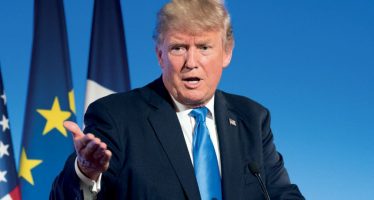Jerome Powell, Chair of the Federal Reserve: The End of Easy Money
It had to happen and it just did.
The untold joys of expansive monetary policy as the engine of growth in lean times are, of course, always of a temporary nature. As the global economy emerges with a vengeance from years of lacklustre growth, the need to keep interest rates at, or close to, zero has all but disappeared. Fiscal policy has returned to the fore as the main driver of events.

Jerome Powell
Most countries reacted quickly to the economic turnaround and busily set about clearing the debris accumulated during the Great Recession that kicked off with the 2008-9 banking crisis; paying down public debt and rebalancing spending deficits – echoing classic Keynesian thought. This is the path chosen by the more successful economies of Europe such as Germany, Sweden, Switzerland, and The Netherlands which now keep their national budgets firmly in the black. Member states of the Eurozone have reduced deficit spending, on average, to just 1.2% of GDP. Public debt, which ballooned during the banking crisis, is also shrinking remarkably fast.
In fact, the picture couldn’t possibly be rosier in places such as Germany. The country sees its economy grow at a healthy pace (2.9%) and reports an almost dizzying 7% expansion of industrial production. The German economy is nearing full employment and creates wealth as never before with a current account surplus equal to 7.8% of the country’s GDP – $291 billion in hard numbers – sparking the ire of President Trump in the US.
Others in Europe take a merry ride on the tailcoats of this Wirtschaftswunder 2.0: Spain, Portugal, France, Belgium, and Italy all saw their performance indicators snap into positive territory. Outside the Eurozone, things are quite peachy as well with Poland and the Czech Republic coming in at close to 5% GDP growth with balanced budgets and budding current account surpluses.
Admittedly, the Eurozone countries are still being pushed forward by the exceptionally generous policies of the European Central Bank which is reluctant to unwind its long-running bond buying programme that injected nearly €2.5 trillion into the economy over a three year period. ECB policymakers are discussing ways to wean the patient, now apparently fully recovered, off the meds. However, the bank will want to carefully manage rate expectations. With a trade war looming and ample room for growth in the labour market, the ECB is determined not to spoil the party.
“With its outsized current account deficit – now amounting to roughly $450 billion or 2.4% of GDP – the US needs its ‘kind strangers’ as much as the UK does.”
The view from Washington is a different one. Going by the tweets emanating almost daily from the White House, the US economy is in a poor state and stands in need of plenty fiscal support and tariff protection whilst being preyed upon by evil people conspiring to cart away the bread and butter of hardworking folks.
Curiously, that is not how corporate America sees things. The National Federation of Independent Business (NFIB) reports that company bosses and owners have become an optimistic bunch. Their believe in a better future now stands at its highest since 1983. At big corporations, CEOs are also upbeat with Business Roundtable – their lobby group – claiming that confidence in the economy has never been higher. Meanwhile, consumer confidence, as measured by the Conference Board, surged to a 17-year high and looks set to increase even further.
The buoyant spirit reigning on the work floor and at corporate offices only serves to confirm the suspicion that Washington’s grip on events in the nation is not quite as tight as those inside the Beltway like to believe. The political pandemonium in the capital, mostly caused by a barely functional federal administration, has so far failed to derail the country which seems to simply ignore the unedifying turf wars and scandals to plot its own course.
Professor Jason Furman of the Harvard Kennedy School of Government in Cambridge, Massachusetts, and former chairperson of President Obama’s Council of Economic Advisers, likens the US economy to a supertanker which is not easily steered off course or stopped: “The uncertainty seen in the White House has only been a small negative. No one making business or consumption decisions is seriously affected by these things.”
Most analysts agree that both businesses and households have now learnt to tune out President Trump’s blustering tweets and focus instead on the fundamentals. “Those fundamentals were strong before Mr Trump was sworn into office and have remained fairly strong throughout,” says Senator Chris van Hollen (D-MD) pointing out that the US economy created more jobs in each of the four years of President Obama’s second term in office than in President Trump’s freshman year at the White House – “and the present administration benefits from a global economic upswing too.”
In all fairness to the much-maligned US president, the $1.5 trillion in tax cuts approved last December did help move things along as did the administration’s decision to dismantle regulations deemed unfriendly to business. However, the Trump White House seems well aware of the dangers implied in the current disconnect between political and economic realities.
President trump wrapped up his first year in office with the lowest approval rating of any president in living memory. According to performance management consultant Gallup, Mr Trump’s first-year approval rating averaged out at just 39%. Surveys show that most Americans find their president divisive and not really fit for public office. The bright spot is that a majority of those queried agree that the president is helping rather than hurting the economy with his policy initiatives.
Perhaps it is a case of learning how to love The Donald. All the same, GOP leaders are quite worried as they eye the November midterm elections when the full House of Representatives is up for grabs as well as 33 of the 100 seats in the US Senate. For Republicans, the first omens spell disaster.
In a mid-March congressional by-election (“special election” in the US) in Pennsylvania, Democrat candidate Conor Lamb, a former marine and federal prosecutor, swept to victory in the staunchly Republican and affluent Allegheny County district where President Trump won by a twenty point difference in 2016. More disconcertingly, a surprise visit by the president in person just before the election did nothing to sway public opinion.
In nineteen other by-elections that have so far taken place this year, Democrats have fared surprisingly well. In Kentucky’s 49th district, Democrats trailed by an embarrassing 49 points in the last presidential vote just two years ago, but went on to claim an astonishing 37-point win in the February congressional by-election – an almost unprecedented swing of 86 percentage points.
Analysts of the Washington maelstrom are worried that the Trump Administration may have overreached with its bullish trade policy which already has started to affect domestic prices for steel and aluminium, eliciting complaints from contractors and manufacturers who fear their already razor-thin margins may evaporate. US businesses are alarmed at the administration’s determination to pick a fight with China by imposing tariff surcharges on $50 billion worth of imports from that country – a move aimed at addressing the $375 billion deficit in bilateral trade.
Whilst corporate America shares President Trump’s concerns about China’s unfair trade practices, such as the theft of intellectual property, dumping, currency manipulation, and restrictions on inward trade and investment, most business leaders consider tariff walls counterproductive as these are widely expected to cause significant added costs to both US manufacturers and consumers.
The National Retail Federation (NRF) came out swinging against the tariffs on Chinese goods, saying ordinary Americans should not be expected to pay the price for China’s misbehaviour. “Middle class Americans are just now beginning to see the benefits of the tax reform and the tighter labour market in their paycheques. A trade war will soon erase these gains,” says NRF president Matthew Shay.
The farming and aerospace sectors are also concerned that President Trump may have put a target on their backs. US farmers sold almost $13 billion worth of soybeans to China in 2017 whilst aircraft manufacturers that year exported over $16 billion in planes and parts to the country. The Information Technology Industry Council mobilised a group of 46 industry and trade associations for a last-ditch appeal to the president reminding Mr Trump that his new tariffs would trigger a “chain reaction of negative consequences” for the US economy and likely provoke retaliatory measures that could stifle exports and raise the cost of doing business. However, not everybody jumped on the bandwagon. Defence contractor Lockheed Martin said it welcomed the measures and the administration’s focus on protecting “the intellectual property of the US defence and aerospace industry.”
So far, President Trump seems underwhelmed by the opposition to his more hands-on trade policy. He did, grudgingly, exempt European steel and aluminium producers from the tariff surcharges, after his trade envoy Robert Lighthizer was told in no uncertain terms by EU Trade Commissioner Cecilia Malmström to expect immediate tit-for-tat retaliatory tariffs on US exports to Europe. Brussels was in no mood to compromise and scored an easy victory by flexing its collective muscle and calling the president’s bluff.
The trade war President Trump is almost hell-bent on starting is part of a larger policy initiative that seeks to Make America Great Again via easy-to-digest populist measures. After all, bashing the Chinese and blaming them for assorted domestic ills, real or imagined, is fun and goes down well with President Trump’s blue collar electorate which at any time could wake up and go Democrat.
Not one to read the small print or overthink complexities, President Trump has imposed a simple, if not simplistic and almost unidimensional, economic policy that calls for the US to bully and spend its way out of trouble. The bullying bit is all about building tariff walls and the spending bit is all about a relaxed attitude to fiscal propriety.
Parallel to the mammoth tax cut, a bewildering number of spending initiatives have been unfurled. Amongst them, an additional $80 billion for the military in 2018, $63 billion on various programmes to keep Democrats from filibustering, and a $200 billion initial outlay to begin fixing the country’s degraded infrastructure – for a grand total well in excess of $1 trillion. As a result, the budget deficit is set to balloon to over 6% of GDP by 2020 – a level it is expected to stay at for the foreseeable future.
Putting paid to the popular notion that Republicans – or conservatives in general – are budget hawks and prudent minders of the exchequer, President Trump has reverted to his role a big spender. That got him into trouble as a businessman – with his companies filing for bankruptcy four times – and may now get his country into trouble as well.
The extra federal spending comes at an inopportune moment – it always sort of does. The budget is already 4.5% in the red and the national debt stands at almost $19 trillion – or 104% of GDP. Just before ending her four-year term at the Federal Reserve, Janet Yellen warned of a surge in US public debt; a development, she told Congress, that should keep people awake at night.
Expressing “significant concern” over the trajectory and sustainability of the debt burden, Mrs Yellen told lawmakers she worries about the feasibility of the multi-decade outlook presented by the Congressional Budget office which she deemed overly optimistic. She also said that no economic study has ever managed to prove a direct link between lower taxes and higher levels of investment: “We have only empirical information to go by and that is sketchy at best.” Mrs Yellen did, however, call on Congress to prioritise investments in education, innovation, and infrastructure – the primary drivers of productivity and, hence, prosperity. She warned that the “dismally slow” growth of productivity hampers the longer-term US economic outlook.
Republicans failed to take heed. The federal budget and the revised tax code pay but scant attention to the key areas highlighted by Mrs Yellen and are geared to spur short-term growth to the inevitable detriment of long-term well-being.
As the Trump Administration prepares to spend its way to the mid-term elections and beyond, the US economy – for all its outward appearance of strength – may look considerably less resilient when examined up close. Job growth has slowed in January and February and now hovers around a level last seen in 2016 when GDP growth amounted to a paltry 1.8%. The US job market may even be less robust than it seems. Unemployment statistics ignore people who have given up on searching for a job. In 2000, some 82% of Americans aged between 25 and 54 were gainfully employed. That number has dropped to 79%, signalling the existence of a hidden pool of labour with about 3.7 million potential workers. It is one explanation for the rather mysterious absence of strong wage pressures and the attendant lack of inflationary pressure.
Which leads to the question of cheap money – is it here to stay or will it go? For now, the Federal Reserve (see the accompanying profile of its chairman Jerome Powell) seems unwilling to go either way. Yes, the Fed will push its base rate up, but is expected to do so hesitantly and in the tiniest of baby steps. The Fed has but little wiggle room, knowing full well that for now the US economy has barely left the recovery stage.
An underreported sign of its somewhat less than robust health is the surprising weakness of the US dollar which has retreated 10% against the euro and – more important – also 10% against a trade-weighted basket of world currencies since Q1 2017. The depreciation has forex traders mystified: the upward revision of economic forecasts, monetary tightening, fiscal stimulus, and even a tax reform that encourages capital inflows should all have contributed to a stronger dollar. Worse than that, markets actually expect the dollar to lose about a quarter of its value over the next ten years given the discrepancy in interest rates. The benchmark 10-year US Treasury bond now pays 230 basis points above its German equivalent and 280 basis points over rates of similar bonds in Japan.
The weakness of the dollar may, of course, also be part explained by the now significantly better economic performance reported in Europe and some Asian markets. However, the money made here is not finding its way to the US just yet. Notwithstanding the enticement of higher interest rates, global markets prefer to hang on to their cash, sending a clear signal that the US economy, in their opinion, is not on a sustainable footing.
This is a problem for – and offers a quandary to – both President Trump and Mr Powell over at the Fed. With its outsized current account deficit – now amounting to roughly $450 billion or 2.4% of GDP – the US needs its “kind strangers” as much as the UK does. Should those kind and moneyed strangers decline the invitation to fund the deficit, added enticements are called for – i.e. higher rates.
There is a reason why the likes of Germany, Japan, and Switzerland insist on keeping at the right side of the current account equation: large deficits inevitably lead to constraints on monetary policy by restricting the freedom of action enjoyed by central banks. The Fed in the US may wish to tread a carefully plotted path between growth and inflation, but kind strangers may not be so impressed and decline a stroll. Just imagine China becoming seriously upset with the White House’s antics on trade and reducing its exposure to its markets. That would perhaps not quite be the end of the world as we know it, but all the same: perish the thought.
Chances are, that with Mr Trump in charge, cheap money will soon be but a faint memory. A saving grace, he does not need to bear all the blame for the predicament and may share that honour with a number of predecessors who also failed to address the structural and underlying issues that cause the US economy to remain stuck in its boom-and-bust cycles.




















































































